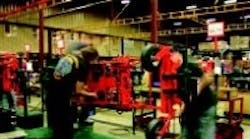When we investigated our alternatives [for a new production line] we decided the three most important evaluation factors would be safety, quality and productivity," says John Orth, plant manager for Ferris Industries, Munnsville, N.Y. The company manufactures Simplicity and Snapper brand zero-turn-radius lawn mowers.
Since the company installed a towline conveyor system from SI Systems (Easton, Pa.) it has cut cycle times by half, says Orth. "We've done it by systematically pacing the production and balancing workstation assignments."
Along with the installation of new material handling hardware, the company adopted lean manufacturing concepts to reduce many of its off-line material handling moves. These moves added no value to the assembly process. The assembly line consists of 12 stations along a 340-foot-long line, which now incorporate many of the bench subassembly activities as part of the final assembly process.
Towline conveyor with a twist
The assembly line at Ferris is simple in mechanical terms. It is a basic index-and-dwell system, ideal for assembly of products that require more than 60 seconds of operator activity, and four-way access to the product. In a traditional system the desired throughput of assembly is entered into a program, which determines how often the line indexes. When all of the operators complete their tasks, they signal that they are done and the line indexes forward.
"The indexing program we've installed," says Craig Sleep, executive account manager for SI Systems, "features indexes that are selectable." The Ferris assembly line allows operators to stop the indexing, or movement of the product to the next workstation, if their task is not complete.
"Prior to an index, or line movement, we give an audible and visual alarm indicating that the system is ready to start up," explains Sleep. "If the operator needs additional time, he hits a button to inhibit the indexing or moving of the line."
This ability serves management as well. Managers know quickly where bottlenecks in assembly might be or what station has an imbalance of work.
The primary line is a linear system where the chain moving the assembly carriers is synchronous. The ergonomically designed carriers have fixtures that rotate the mowers to proper assembly angles and eliminate much of the bending and stretching associated with assembly work. Orth says Ferris used in-house talent to design and build the carriers and, in the process, lowered its cost of investment in the system.
The versatile line is used to build a variety of mowers: the 44- and 50-inch-wide mower deck Simplicity Consumer Z models, the 44- and 50-inch-wide mower deck Snap-per fast cut and zero-turn models.
Nonsynchronous synchronization
After the final assembly station, where the product is unloaded, there is another run of nonsynchronous chain moving constantly at about 60 feet per minute. The second line returns empty carriers to the start of the assembly process. It saves valuable floor space by running through a tunnel in the bottom level of some racking.
Along this nonsynchronous line are two accumulation stops to selectively disengage carriers from the chain. The down-stream station on the line is a load station, the starting point for assembly. At this station, the operator loads the frame, the first piece of assembly, onto the carrier. The carrier then dwells and moves into position where it will be picked up the next time the main line indexes forward.
"The plant is a model of manufacturing efficiency and a tribute of how lean manufacturing and innovation can breathe new life into a former rust belt factory," says Orth, adding that Ferris has increased the shop workforce fivefold over the past few years.
Carriers attached to the towline conveyor were designed to present the work to the assembler in the best ergonomic position.
Making best use of the space available, the line to move carriers back to the start of the assembly line travel through a tunnel beneath the racks.





